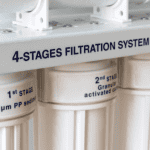Tannins are natural organic compounds found in water, often resulting from the decomposition of plant materials such as leaves or tree bark. They can cause water to have a yellow or brown color, an unpleasant taste or odor, and even stain fixtures, laundry, and appliances. The process of removing tannins from water can improve not only the water’s aesthetics but also its overall quality and safety for consumption and household use.
There are several methods for effectively removing tannins from water, including activated carbon filtration, ion exchange resins, and reverse osmosis. Activated carbon filters use adsorption to attract and trap tannins, allowing clean water particles to pass through. Ion exchange resins, commonly found in water softeners, work by using positively charged ions to attract and remove negatively charged tannins, with salt being used to keep the resin bed fresh and clean. Reverse osmosis, on the other hand, relies on pressure to force water through a semi-permeable membrane that filters out tannins along with other contaminants.
Various factors, such as water hardness, the concentration of tannins, and budget, can all influence the choice of method for tannin removal. It’s essential to understand these methods and consider each’s benefits and limitations before selecting the most suitable option for one’s individual needs.

Understanding Tannins
Sources of Tannins
Tannins are a group of organic materials that are commonly found in water sources. They are generally derived from plant material like leaves, bark, and roots, as well as some types of algae. The presence of tannins in water can vary depending on the geographic location, season, and proximity to plant matter.
Some common sources of tannins include:
- Decaying plant matter in lakes, rivers, and streams
- Tea, coffee, and some fruits
- Agricultural runoff
- Leaching from soil and peat
Effects on Water Quality
Tannins can have several effects on water quality, including:
- Color: Higher concentrations of tannins can lead to a yellow or brownish tint in the water. This discoloration is often more noticeable in surface water bodies like lakes and rivers.
- Taste & Odor: Water with high tannin levels can have an earthy or musty taste and odor, which can be off-putting to some consumers.
- Interaction with other contaminants: Tannins can react with other contaminants in the water, such as metals and minerals, forming complex compounds. Some of these compounds, like humic and fulvic acids, can be difficult to remove through conventional water treatment methods.
In order to effectively remove tannins and other associated contaminants, various methods can be employed. These include:
- Activated carbon filters: These filters use a process known as adsorption, where tannins and other contaminants stick to the surface of the filter media, allowing clean water to pass through.
- Ion exchange resins: Positively charged resins attract negatively charged tannins, removing them from the water. This salt-assisted regeneration process can also help maintain the efficiency of the resin bed.
- UV light systems: Ultraviolet light can break down tannins into smaller, less complex compounds that can be more easily removed through filtration.
By understanding the sources and effects of tannins in water, appropriate strategies can be implemented to ensure a safe and pleasant water supply.
Detecting Tannins in Water
Visual and Sensory Indications
Tannins in water can be initially identified through visual and sensory observations. Some common indicators of tannins presence in water are:
- Appearance: Water containing tannins may exhibit a tea-like color, which can range anywhere from a slight yellow tint to a more intense brownish hue.
- Taste: Tannins can impart an unpleasant, bitter or astringent taste to the water.
- Odor: Water with tannins may have a musty or earthy odor, often compared to the smell of wet soil or decaying leaves.
If you notice any of these signs, it is essential to test your water for tannins to confirm their presence and determine the concentration levels.

Water Testing Methods
To accurately detect and measure the concentration of tannins in your water, you can use the following testing methods:
-
Home Test Kits: Water test kits are available for purchase that can detect tannins and other contaminants. These kits usually consist of test strips, dropper bottles, or color comparator trays. Make sure to choose a test kit specifically designed for tannin detection.
-
Laboratory Analysis: For a more comprehensive analysis, you can send a water sample to a certified laboratory for testing. This approach provides a detailed report of tannin concentration and any other potential contaminants in your water.
Keep in mind that while visual and sensory observations can give a preliminary indication of tannins in water, testing is the most accurate method to confirm their presence and determine appropriate treatment options.
Tannin Removal Methods
Ion Exchange
Ion exchange is a water treatment method which is prevalent in water softening systems to remove hardness using salt. The same process can also be used for removing tannins from water. Ion exchange involves the swapping of ions between a solid resin and a liquid solution. In this process, the tannins in water are attracted to the resin’s surface, causing them to be replaced by sodium ions, thus effectively removing them.
Reverse Osmosis
Reverse osmosis is another viable option for tannin removal. This process uses a semi-permeable membrane that allows water molecules to pass through while effectively blocking contaminants, including tannins. The pressure applied to the water source ensures the contaminants are directed to the waste side of the membrane, while clean water is collected on the other side. Reverse osmosis can remove not only tannins but also a wide range of dissolved solids, making it an efficient option for water treatment.
Activated Carbon Filtration
Activated carbon filtration utilizes a process called adsorption to remove various water contaminants, including tannins. During the filtration process, tannins and other impurities in the water are attracted to the surface of the activated carbon, while water molecules can easily pass through. Activated carbon filters are widely used due to their effectiveness in improving overall water quality.
Chemical Oxidation
Chemical oxidation is an advanced method used for treating tannin-rich water. This technique involves adding chemical oxidizers (such as chlorine or hydrogen peroxide) into the water, which react with tannins and break them down into smaller, more manageable particles. The oxidized particles are then removed from the water through filtration, thus ensuring tannin-free water.
In summary, there are several methods to remove tannins from water, including ion exchange, reverse osmosis, activated carbon filtration, and chemical oxidation. The choice of a tannin-removal technique depends on the specific needs and preferences of the end-user.
Specific Applications
Removing Tannins in Drinking Water
Tannins can cause discoloration and musty taste in drinking water, which may affect its overall quality and appearance. In order to remove tannins from drinking water, you can employ various methods:
- Activated Carbon Filters: Carbon filters effectively remove tannins and improve the taste, odor, and clarity of water.
- Water Softeners: Though primarily used for hardness removal, water softeners that use ion exchange resin can remove some tannins from water as well.
- Reverse Osmosis (RO) Systems: RO systems not only remove tannins, but also provide additional filtration to remove various impurities and contaminants from water.
It’s essential to regularly maintain and change filter cartridges or media to ensure their efficiency in tannin removal.
Managing Tannins in Aquariums
Tannins released from driftwood, peat, or other natural materials can cause the aquarium water to become brownish and affect the well-being of the fish. Here are some ways to manage tannins in aquarium water:
-
Water Changes: Regular water changes help dilute tannins, ensuring healthier water quality for your fish. Replace 20-30% of the aquarium water weekly or as needed, depending on the tannin levels.
-
Using Purigen: Purigen is a high-capacity absorbent that effectively removes tannins and other organic compounds. Placed in a filter media bag and attached to the aquarium filter, Purigen helps maintain clear water while preserving essential trace elements.
-
Carbon and Mechanical Filtration: Activated carbon filters, sponge filters, and filter floss can help in reducing tannin levels in aquarium water. Again, remember to change or clean the filter media regularly for optimal results.
Keep in mind that while tannins can discolor aquarium water, they also provide a more natural and comfortable environment for certain fish varieties, such as blackwater species. It is necessary to strike a balance between removing tannins to maintain clarity and maintaining an appropriate level of tannins for the comfort of your fish.
Impact on the Environment and Ecosystem
Tannins are natural organic substances that exist in plant matter such as leaves, bark, and wood. They are released into the environment through various means such as the breakdown of plant matter and runoff from rainwater. Although tannins are generally considered benign and harmless to the environment, their presence in water bodies can have different impacts on the local ecosystem.
One notable effect of elevated tannin levels in water is the creation of low-lying, marshy areas. When tannins leach into the ground, they can bind with various elements and minerals to form acidic soil. This gradually results in the formation of swamps or marshes as the soil’s acidity increases. These wetlands, although rich in biodiversity, can have negative implications for surrounding landscapes.
In aquatic ecosystems, high concentrations of tannins can affect the clarity of water and decrease light penetration. This can lead to:
- A decline in photosynthesis, which reduces the oxygen content in the water and affects the survival of aquatic plants and animals.
- Changes in the structure and function of microbial communities, as some species might be more sensitive to high tannin levels than others.
Another significant impact of tannins on the environment is their role in nutrient cycling. As the tannins in runoff and plant matter decompose, they release nutrients such as nitrogen and phosphorus into the soil and water. This process typically benefits plant growth but can lead to an imbalance in nutrient levels if there is an excessive supply of tannin-rich plant matter.
In summary, the presence of tannins in water can influence various aspects of the environment and ecosystem, including soil formation, aquatic life, and nutrient cycling. While tannins are natural components found in plant matter, understanding and monitoring their impacts on ecosystems is essential for maintaining ecological balance and protecting our environment.
Addressing Related Water Quality Issues
Apart from tannins, water may have several other issues that need to be addressed. Some of these include water hardness, and the presence of iron, manganese, and sulfur. In this section, we will discuss how to deal with these related water quality concerns.
Dealing with Water Hardness
Water hardness is primarily caused by the presence of calcium and magnesium minerals in the water supply. To address this issue, a water softener can be utilized. Water softeners typically use a process called ion exchange to remove these hardness minerals. The results are not only reduced hardness but also the potential removal of tannins in the process.
Here are some common methods for treating water hardness:
- Ion exchange water softeners (using salt or salt-free technologies)
- Reverse Osmosis (RO) systems
- Template Assisted Crystallization (TAC) or Nucleation Assisted Crystallization (NAC) technologies
- Chelation or sequestration agents (e.g., polyphosphates)
Removing Iron, Manganese, and Sulfur
Iron, manganese, and sulfur are common elements that can negatively affect water quality. To remove these elements from water, various methods may be employed:
Iron
- Oxidation and filtration (e.g., using aeration or chlorination followed by a sediment or multi-media filter)
- Ion exchange (using water softeners)
Manganese
- Oxidation and filtration (e.g., using greensand filters or potassium permanganate)
- Ion exchange (using water softeners)
- Sequestration agents (e.g., polyphosphates)
Sulfur
- Aeration and filtration (to remove hydrogen sulfide gas through oxidation)
- Activated carbon filters (to adsorb the hydrogen sulfide gas)
- Ion exchange (using water softeners)
The most appropriate method for removing iron, manganese, and sulfur will depend on their concentrations and the other water quality issues present. Consulting a water treatment professional for recommendations can help ensure a comprehensive solution for improving water quality.
Maintenance and Cost Considerations
Filter Maintenance and Replacements
Regular maintenance is essential to ensure the proper functioning and efficiency of your water filtration system. For removing tannins, activated carbon filters and ion exchange systems can be used. Typically, activated carbon filters require replacement every 3 to 6 months, while ion exchange systems need resin replacement every 3 to 5 years.
In addition to filter replacements, whole-house tannin filter systems require backwashing and regeneration every two days. This process uses brine water and involves adding 2-3 bags of salt monthly, along with 50-80 gallons of regenerating water per cycle1.
For reverse osmosis filters, regular maintenance includes replacing the pre and post filters every 6 to 12 months and the RO membrane every 2 to 3 years. Also, remember to check and clean components, such as the storage tank and O-rings, periodically. Conducting routine laboratory tests for tannin levels at least three times a year can help you ensure the system is working effectively2.
Long-Term Cost Assessments
It is essential to consider both upfront and long-term costs when choosing a water filtration system. Whole-house tannin filters have an initial cost range of $800 to $30001. Under-sink carbon purifiers cost around $500 to $6002. In addition to the initial cost, factor in maintenance and replacement expenses.
For whole-house tannin filters, estimate the cost of salt and regenerating water, along with any labor costs for specialized maintenance. For activated carbon filters, consider the replacement costs and the frequency with which they need changing. With ion exchange systems, factor in the price of the resin replacement and other maintenance requirements.
Lastly, reverse osmosis filters involve replacing multiple components, such as pre and post filters and RO membranes, and these costs should be factored into your long-term assessment.
In summary, when choosing a water filtration system to remove tannins, it’s essential to consider both the initial investment and ongoing maintenance costs. Conducting routine laboratory tests will ensure your system remains effective in delivering high-quality, tannin-free water.









